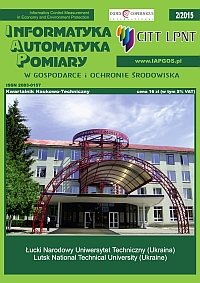EYE-TRACKING IN DIAGNOSIS OF NEURODEGENERATIVE DISEASE
Article Sidebar
Open full text
Issue Vol. 5 No. 2 (2015)
-
SUPERVISION OF LABORATORY MEASURING EQUIPMENT BASED ON THE EXAMPLE OF ILLUMINANCE METERS
Agnieszka Banaszak, Justyna Wtorkiewicz3-5
-
FRACTAL GEOMETRIES IN LATERAL FLUX CAPACITOR DESIGN – EXPERIMENTAL RESULTS
Piotr Kocanda, Andrzej Kos, Adam Gołda6-9
-
EXPANSION OF THE DISCHARGE ARC IN THE AXIAL MAGNETICAL FIELD
Krzysztof Krasuski10-12
-
INNOVATIVE PROJECT OF MECHANISM FOR TOOLS LAPAROSCOPIC
Łukasz Mucha13-17
-
PREDICTIVE CURRENT CONTROLLER WITH MTPA CONTROL STRATEGY – SIMULATION RESULTS
Rafał Piotuch18-21
-
OPTIMIZATION OF 3D LOCAL ORIENTATION MAP CALCULATION IN THE MATLAB FRAMEWORK
Ranya Al Darwich, Laurent Babout22-24
-
TRACTION RECTIFIER-INVERTER SUBSTATION CONCEPT FOR 3 KV DC RAILWAY TRACTION SYSTEM
Włodzimierz Kruczek25-29
-
UTILIZATION IONEX FILE FOR POSITIONING CORRECTION OVER RYKI DISTRICT AREA
Kamil Krasuski30-34
-
UTILISATION OF ÅNGSTRÖM METHOD FOR ESTIMATING A THERMAL DIFFUSIVITY OF CHARGE IN INDUCTION HEATING SETUP
Adam Cieślak, Jerzy Zgraja35-38
-
METHODS OF EEG ARTIFACTS ELIMINATION
Małgorzata Plechawska-Wójcik39-46
-
ELECTRICAL PROPERTIES OF (FeCoZr)x(Al2O3)(100-x) NANOCOMPOSITES PRODUCED BY SPUTTERING OF ARGON AND OXYGEN BEAM AS CAPACITOR SYSTEMS
Konrad Kierczyński, Tomasz Kołtunowicz47-54
-
EYE-TRACKING IN DIAGNOSIS OF NEURODEGENERATIVE DISEASE
Magdalena Borys55-63
-
PHOTOVOLTAIC SYSTEMS IN BUILDINGS – MODEL OF WORK IN LUBLIN CLIMATE CONDITIONS AND ENVIRONMENTAL ASPECTS
Agnieszka Żelazna64-71
-
AUTOMATION OF ROAD TRAIN MOTION IN REVERSE
Pavlo Gumenyuk72-80
-
Mapa rozwoju dyscypliny Elektrotechnika
Tadeusz Citko81-93
Archives
-
Vol. 7 No. 4
2017-12-21 23
-
Vol. 7 No. 3
2017-09-30 24
-
Vol. 7 No. 2
2017-06-30 27
-
Vol. 7 No. 1
2017-03-03 33
-
Vol. 6 No. 4
2016-12-22 16
-
Vol. 6 No. 3
2016-08-08 18
-
Vol. 6 No. 2
2016-05-10 16
-
Vol. 6 No. 1
2016-02-04 16
-
Vol. 5 No. 4
2015-10-28 19
-
Vol. 5 No. 3
2015-09-02 17
-
Vol. 5 No. 2
2015-06-30 15
-
Vol. 5 No. 1
2015-03-31 18
-
Vol. 4 No. 4
2014-12-09 29
-
Vol. 4 No. 3
2014-09-26 22
-
Vol. 4 No. 2
2014-06-18 21
-
Vol. 4 No. 1
2014-03-12 19
-
Vol. 3 No. 4
2013-12-27 20
-
Vol. 3 No. 3
2013-07-24 13
-
Vol. 3 No. 2
2013-05-16 9
-
Vol. 3 No. 1
2013-02-14 11
Main Article Content
DOI
Authors
Abstract
Eye-tracking allows for non-invasive examination and the same eyetrackers are becoming more available, thus its popularity in medical diagnosis and other fields of application is increasing. The paper presents the possibilities for using eye-tracking in the diagnosis neurodegenerative disease such as Parkinson or Alzheimer diseases. The autor describes the exetracking experiment, the model of fixations and saccedes detection, as well as the selected examples of eye-tracking research conducted among patients with neurodegenerative diseases.
Keywords:
References
Anderson T.J., MacAskill M.R.: Eye movements in patients with neurodegenerative disorders. Nature Reviews Neurology, 9(2), 2013, 74-85.
Duchowski, A.: Eye tracking methodology: Theory and practice, Vol. 373, Springer Science & Business Media, 2007.
Garbutt S., Matlin A., Hellmuth J., Schenk A.K., Johnson J.K., Rosen H., Boxer A.L.: Oculomotor function in frontotemporal lobar degeneration, related disorders and Alzheimer's disease. Brain, 131(5), 2008, 1268-1281.
Holmqvist K., Nyström M., Andersson R., Dewhurst R., Jarodzka H, Van de Weijer J.: Eye tracking: A comprehensive guide to methods and measures. Oxford University Press, 2011.
Jadanowski K., Budrewicz S., Koziorowska-Gawron E.: Zaburzenia gałkoruchowe w chorobach ośrodkowego układu nerwowego. Polski Przegląd Neurologiczny, 6(4), 2010, 202-211.
Komogortsev O.V., Gobert D.V., Jayarathna S., Koh D.H., Gowda S.M.: Standardization of automated analyses of oculomotor fixation and saccadic behaviors. Biomedical Engineering, IEEE Transactions, 57(11), 2010, 2635-2645.
Komogortsev O.V., Jayarathna, S., Koh D.H., Gowda S.M.: Qualitative and quantitative scoring and evaluation of the eye movement classification algorithms. Proceedings of the 2010 Symposium on Eye-Tracking Research & Applications ACM, 2010, 65-68.
Komogortsev O.V., Khan J.I.: Kalman filtering in the design of eye-gaze-guided computer interfaces. Human-Computer Interaction. HCI Intelligent Multimodal Interaction Environments, Springer Berlin Heidelberg, 2007, 679-689.
Kuechenmeister C.A., Linton P. H., Mueller T.V., White H.B.: Eye Tracking in Relation to Age, Sex, and Illness. Arch Gen Psychiatry, 34(5), 1977, 578-579.
Mosimann U.P., Müri R.M., Burn D.J., Felblinger J., O'Brien J.T., McKeith I.G.: Saccadic eye movement changes in Parkinson's disease dementia and dementia with Lewy bodies. Brain, 128(6), 2005, 1267-1276.
Ober J., Dylak J., Gryncewicz W., Przedpelska-Ober E.: Sakkadometria–nowe możliwości oceny stanu czynnościowego ośrodkowego układu nerwowego. [Saccadometryp-new possibilities of evaluating the state of the central nervous system activity]. Nauka, 4, 2009, 109-135.
Peltsch, A., Hoffman, A., Armstrong, I., Pari, G., Munoz, D.P.: Saccadic impairments in Huntington’s disease. Experimental brain research, 186(3), 2008, 457-469.
Salvucci D.D., Goldberg J.H.: Identifying fixations and saccades in eye-tracking protocols. Proceedings of the 2000 symposium on Eye tracking research & applications. ACM, 2000, 71-78.
Sauter D., Martin B.J., Di Renzo N., Vomscheid C.: Analysis of eye tracking movements using innovations generated by a Kalman filter. Medical and biological Engineering and Computing, 29(1), 1991, 63-69.
Terao Y., Fukuda H., Yugeta A., Hikosaka O., Nomura Y., Segawa M., Ugawa Y.: Initiation and inhibitory control of saccades with the progression of Parkinson's disease–changes in three major drives converging on the superior colliculus. Neuropsychologia, 49(7), 2011, 1794-1806.
Verheij S., Muilwijk D., Pel J.J., van der Cammen T.J., Mattace-Raso F.U., van der Steen J.: Visuomotor impairment in early-stage Alzheimer's disease: changes in relative timing of eye and hand movements. Journal of Alzheimer's Disease, 30(1), 2012, 131-143.
Article Details
Abstract views: 323
License

This work is licensed under a Creative Commons Attribution-ShareAlike 4.0 International License.






